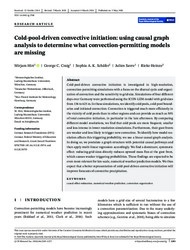Cold-pool-driven convective initiation: using causal graph analysis to determine what convection-permitting models are missing
DOI: https://doi.org/10.1002/qj.3788
Persistent URL: http://resolver.sub.uni-goettingen.de/purl?gldocs-11858/8875
Persistent URL: http://resolver.sub.uni-goettingen.de/purl?gldocs-11858/8875
Hirt, Mirjam; Craig, George C.; Schäfer, Sophia A. K.; Savre, Julien; Heinze, Rieke, 2020: Cold-pool-driven convective initiation: using causal graph analysis to determine what convection-permitting models are missing. In: Quarterly Journal of the Royal Meteorological Society, Band 146, 730: 2205 - 2227, DOI: 10.1002/qj.3788.
 |
Dokument öffnen: |
Cold-pool-driven convective initiation is investigated in high-resolution, convection-permitting simulations with a focus on the diurnal cycle and organization of convection and the sensitivity to grid size. Simulations of four different days over Germany were performed using the ICON-LEM model with grid sizes from 156 to 625 m. In these simulations, we identify cold pools, cold-pool boundaries and initiated convection. Convection is triggered much more efficiently in the vicinity of cold pools than in other regions and can provide as much as 50% of total convective initiation, in particular in the late afternoon. By comparing different model resolutions, we find that cold pools are more frequent, smaller and less intense in lower-resolution simulations. Furthermore, their gust fronts are weaker and less likely to trigger new convection. To identify how model resolution affects this triggering probability, we use a linear causal graph analysis. In doing so, we postulate a graph structure with potential causal pathways and then apply multi-linear regression accordingly. We find a dominant, systematic effect: reducing grid sizes directly reduces upward mass flux at the gust front, which causes weaker triggering probabilities. These findings are expected to be even more relevant for km-scale, numerical weather prediction models. We thus expect that a better representation of cold-pool-driven convective initiation will improve forecasts of convective precipitation.
Statistik:
ZugriffsstatistikSammlung:
This is an open access article under the terms of the Creative Commons Attribution License, which permits use, distribution and reproduction in any medium, provided the original work is properly cited.

